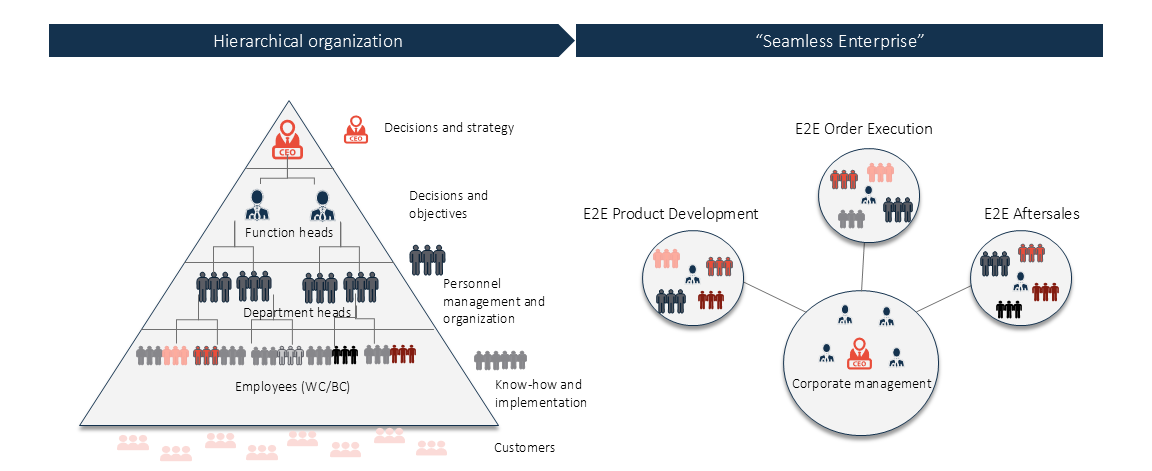
Europe's automotive industry at a turning point:
How end-to-end processes can overcome the crisis

The German automotive industry is in deep crisis. Bosch is cutting more than 12,000 jobs, Continental around 12,200, and at ZF it could be up to 14,000. Since 2014 car production in Germany has fallen by 30% and 50,000 jobs have been lost in the last two years alone - and the trend is accelerating.
Why are we falling behind?
For a long time, "German Engineering" was regarded as a seal of quality, but that is no longer enough. While European manufacturers are still focusing on their premium quality, Tesla and BYD are pushing ahead with digitalization and customer orientation. China has accelerated electromobility and dominates the market. At the same time, long decision-making processes and outdated structures are slowing down European industry. The threat of a trade war is further exacerbating the situation.
The hard truth is that we underestimated the change and reacted too late. Now we have to rethink how to establish a counterweight to the USA and China in Europe.
Areas of action for the future
To remain competitive, the German automotive industry must quickly reinvent itself, cut out old habits and start afresh in the following three core areas:
- Achieve cost and innovation leadership at the same time:
In high-wage countries, efficiency must be massively increased and high location-related wage and non-wage labor costs must be offset by corresponding productivity gains. In addition, a mechanism must be found to offset the high and rising energy costs in order to prevent competitive disadvantages compared to non-European competitors. - New footprint and sourcing concept (local for local):
Regional production for regional markets and regional sourcing must become more of a focus, to avoid trade conflicts. - Cooperation instead of competition in the value chain:
We can only regain our competitiveness through close cooperation with suppliers, tech partners and other market participants.
An important step in the right direction: companies thinking in terms of end-to-end processes
However, speed and flexibility can be achieved only to a limited extend using a classic functional or a complex matrix organization within the existing process landscape. The high number of interfaces and the long, hierarchical decision-making paths prevent agility and customer orientation. But not only the existing organizational structure, also processes and systems are a challenge. Change must also take place in people's minds and in the way we work together.
End-to-End processes are an answer to the crisis in the German automotive industry because they increase efficiency, reduce costs and increase flexibility. They improve supply chain management, reduce bottlenecks and enable faster adaptation to electromobility and digitalization. Consistent data flows optimize production, sales and after-sales, while automation and agile processes shorten the time-to-market.
Which characteristics define end-to end companies?
In contrast to a classic, function-oriented organizational and process landscape, end-to-end processes focus on the customer.
Departmental boundaries and hierarchies are torn down to achieve the goal of short throughput times and high efficiency. Interfaces are eliminated, teams are reorganized and given significantly more decentralized decision-making authority. The focus is on team play NOT on silo thinking.

The role of management is changing from a decision-making and control body to a "Servant Leadership" approach. Managers support, empower and coach employees, to achieve the clearly defined targets (time, quality, costs) independently.
The implementation of end-to-end processes comprises the main value creation processes in a company: the product creation process, the order fulfillment process and after sales.
Process House

The implementation of end-to-end processes is essential for the German automotive industry to remain globally competitive. By digitizing and integrating all process steps, companies can increase their innovative strength, react more flexibly to market changes and speed up decision-making processes.
Advantages of end-to-end (E2E) business processes
- Increased customer satisfaction: If all activities in a process are coordinated in a meaningful and consistent way, this leads to consistent and higher quality work results. Customers receive exactly what they expect, exactly when they expect it.
- Shorter throughput times: E2E processes overcome departmental boundaries, minimize interfaces, unnecessary waiting times and decision backlogs and focus on high process speed.
- Improved efficiency: E2E processes help to focus on value-adding activities, avoid bottlenecks and save time and resources. This leads to a more efficient workflow and the opportunity to make intensive use of the benefits of digitization, AI and process automation.
- Faster adaptability: Consistently designed E2E processes enable companies to quickly identify areas that need to be adapted due to changing market conditions. This flexibility is crucial to remain competitive.
It is time to show courage and rethink traditional structures in favor of more agile approaches. Those who use end-to-end processes remain competitive. Those who continue to cling to rigid structures risk losing touch. It is time for a consistent reorientation - for a competitive European automotive industry of the future.




